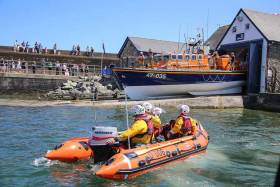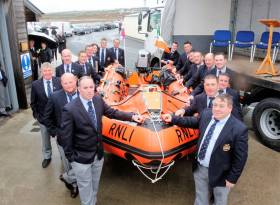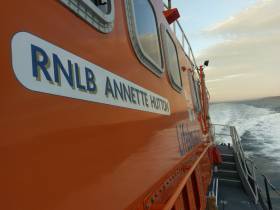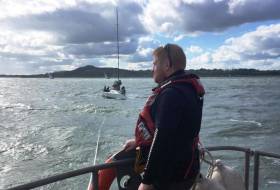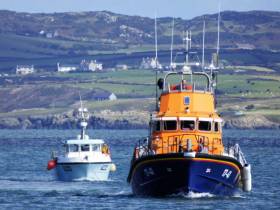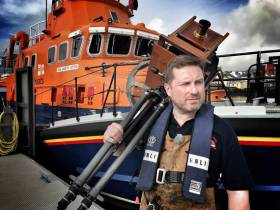Displaying items by tag: RNLI
RNLI Issue Statement Following €6 million Irish Bequest
The RNLI is deeply grateful and humbled by the generosity of Mrs Elizabeth O’Kelly to bequeath over €6 million in her will to the charity. Gifts in wills, be they large or small, are vital to the charity’s work in saving lives at sea, they fund six out of every 10 lifeboat launches.
Mrs O’Kelly who prior to her passing, lived in Stradbally County Laois, was a long-standing supporter of the RNLI. She held a high regard for the volunteer work carried out by the charity which appealed to her ethos and she herself for many years, volunteered her time to help out at an RNLI stall at the RDS in Dublin.
Throughout her life, she displayed great kindness towards her many friends and was most charitable in supporting those in need. This has been reflected in her generous decision to bequest the funds to five charities.
Mrs O’Kelly asked that her legacy be used to support the RNLI’s lifesaving work in Ireland. The impact of her incredible generosity will be directly felt by our volunteer crews and the people whose lives they save for many years to come. As this is such a large legacy, the RNLI will be carefully considering all options to ensure the funds are used where they are needed most and with a view to how they can be spent to fittingly reflect Mrs O’Kelly’s support for the charity.
The RNLI provides a 24-hour search and rescue service and has 46 lifeboats stations in Ireland and 59 lifeboats. In 2017, Irish lifeboats launched 1,088 times and our volunteer crews rescued 1,471 people, that’s an average of four people aided each day.
As a charity, we rely on the generosity of the public to fund our lifesaving service and to ensure our lifeboat stations are properly equipped, our lifeboats are maintained and that our volunteers are highly trained and skilled to continue their work in saving lives at sea.
At 5.27pm on Sunday 28 October, Carrybridge RNLI’s inshore lifeboat, Douglas Euan & Kay Richards and Rescue Water Craft (RWC) launched following a request by Belfast Coastguard to assist a vessel with one person on board which had run aground approximately 1 mile West of Kilmore Quay.
Winds were South Easterly, Force 1. Visibility was good with a clear sky.
The lifeboat and RWC arrived with the casualty vessel and found all to be safe and well after their initial inspection, with no water ingress being observed.
The volunteer crew successfully refloated the vessel and towed it to deeper water, where it was then checked for any water ingress and none was located. The propulsion and steering were tested by the owner and was found to be working fine.
The lifeboat and RWC escorted the vessel back to Knockninny Marina leaving one crew member on board due to the failing light. Once it was secured the crew departed and made their way back to the station arriving at 7.15pm.
Speaking following the call out, Chris Cathcart, Helm at Carrybridge RNLI said: ‘We would remind all boat users before going afloat to plan your passage and to follow the navigation channels. In the event of an emergency, the number to dial is: 999 or 112 and ask for the Coastguard.’’
At 16:15pm on Friday 19 October, Carrybridge RNLI’s inshore lifeboat, Douglas Euan & Kay Richards and Rescue Water Craft (RWC) launched following a request by Belfast Coastguard to assist a vessel with three persons on board which had run aground approximately 1 mile North of Knockninny Marina.
Winds were South Westerly, Force 2. Visibility was good with an overcast sky.
The lifeboat and RWC arrived with the casualty vessel and once on board assessed the vessel for water ingress and none was found.
The volunteer crew successfully refloated the vessel and towed it to deeper water. The boat was again assessed for water ingress, and its propulsion and steering tested. The vessel was found to be ok.
The lifeboat and RWC escorted the vessel for a time as it made its onward journey, after which the crew departed and made their way back to the station arriving at 17:45pm.
Speaking following the call out, Stephen Scott, Deputy Launching Authority at Carrybridge RNLI said: ‘Boat users should be mindful of shallow sections of water and always keep to the main navigation channels. All water users should wear a lifejacket and always carry a means of communication for help. The number to dial should you find yourself in trouble is: 999 or 112 and ask for the Coastguard.’
Ballyglass RNLI’s New Inshore D Class Lifeboat Named 'Clann Lir'
At a special naming ceremony and service of dedication held yesterday (Saturday 13 October), Ballyglass RNLI officially named its new D class lifeboat, Clann Lir, in the Mayo coastal town.
The honour of naming the lifeboat went to Derek Moran, Secretary General of the Department of Finance, with the help of Sophie Reilly from Belmullet National School, winner of a competition to choose the name of the new lifeboat.
The lifeboat which went on service earlier this year was funded by a donation from the Central Bank of Ireland.
The Central Bank, on behalf of the Department of Finance, issues several commemorative coin products every year to mark different historical events, figures and to promote Irish arts and heritage.
The Central Bank had scheduled the launch of its 2017 Annual Mint Set, which paid tribute to the vital work carried out by the Irish Coast Guard and Irish Lighthouses for March 2017. However, the launch was postponed following the tragic loss of the crew of Rescue 116 on 14 March 2017.
Following the tragedy the Minister for Finance agreed that the proceeds from the sale of the Annual Mint Set 2017 be donated to a nominated charity. The RNLI was selected as the main beneficiary of this donation as its work closely aligns with the work of the Irish Coast Guard and the Commissioners of Irish Lights.
Almost 4,900 Annual Mint sets were sold up to the end of January this year and a donation of just over €74,000 was made to the RNLI. The proceeds have been used to fund the new lifesaving vessel which is stationed at Ballyglass, with the remainder going towards lifeboat kit equipment and crew training.
During the naming ceremony, Eddie Diver, Ballyglass RNLI Fundraising Chairman, accepted the lifeboat on behalf of the charity, from Gerry Quinn, Chief Operations Officer of the Central Bank, before handing her over into the care of Ballyglass Inshore Lifeboat Station.
Having accepted the lifeboat on behalf of the volunteer crew, Lifeboat Operations Manager Padraic Sheeran in his address paid tribute to all involved at the station: ‘I thank Eddie for handing us this new D Class lifeboat, and the Central Bank of Ireland for donating it to us. Thanks to everyone here today and to our great supporters of the station. And last but not least a huge thank you to the volunteer crew and fundraising committee - as Lifeboat Operations Manager it’s a pleasure to work with you all.’
The Clann Lir was blessed in a service of dedication led by Father Kevin Hegarty before the lifeboat was officially named by Derek Moran.
The new inshore lifeboat replaces The Western which launched 58 times while on service in Ballyglass coming to the aid of 20 people. Clann Lir will now serve alongside Ballyglass RNLI’s all-weather lifeboat Bryan and Gordon which has launched 153 times since going on service in Ballyglass, with her crews coming to the aid of 153 people, 14 of whom were lives saved.
The name of the new lifeboat is one close to the heart of those in the Belmullet community and was chosen by Sophie Reilly, a pupil at Belmullet National School.
Pupils in the school were given the task of nominating a suitable name for the lifeboat that had to be Irish with either a nautical or community theme. Three names were shortlisted by the volunteers in Ballyglass RNLI before the station’s volunteers picked a fitting winner, Clann Lir.
Clann Lir or The Children of Lir, is an Irish legend that tells the story of Lir and his four children. Bodb Dearg, king of the Tuatha De Danann and rival of Lir, gave his daughter Aeb to Lir, in order to appease him. Lir and Aeb had four children: one girl, Fionnuala, and three sons: Aed and twins Fiachra and Conn. Aeb died and Bodb Dearg sent another of his daughters, Aoife, to marry Lir.
Aiofe was jealous of the children's love for their father and for this reason she decided to kill them but did not have the courage; instead using her magic she changed the children into swans. They were condemned to wander for 900 years over certain lakes and rivers in Ireland.
The children had to spend 300 years on Lough Derravaragh, 300 years in the Sea of Moyle and their last 300 years as swans at Sruwaddacon Bay near Erris in County Mayo, before flying to Inishglora, an island off the coast of the Belmullet Peninsula.
Here they met a monk who baptised them. Instantly they had back their human shapes but because of their very old age they died immediately. They were buried on the island in the one grave.
The RNLI formally established a lifeboat station in Ballyglass in 1989 and today the volunteers work from two stations that are home to an all-weather lifeboat, Bryan and Gordon, and the new inshore lifeboat.
The D class lifeboat has been the workhouse of the RNLI’s lifesaving service for nearly 50 years. It is inflatable but robust; highly manoeuvrable and capable of operating much closer to shore than all-weather lifeboats. It is specifically suited to surf, shallow water and confined locations, often close to cliffs, among rocks or even in caves.
First introduced to the fleet in 1963, the design of the D class has continued to evolve since its introduction and the latest version was introduced in 2003. As with all D class lifeboats, the Clann Lir has a single 50hp outboard engine and can be righted manually by the crew after a capsize. Onboard equipment includes both fitted and hand-held VHF radios, night-vision equipment, and first aid kit, including oxygen.
The 5m lifeboat is landrover launched and has a 25-knot maximum speed. It can carry up to three lifeboat crew and five survivors.
A crowd of well-wishers turned up to see the lifeboat officially named with a bottle of champagne poured over the side of the boat at the end of the ceremony.
Among the guests on the platform party were Michael Cosgrove, fundraising secretary who welcomed guests and opened proceedings, Gerry Quinn, Chief Operations Officer of the Central Bank of Ireland who handed over the lifeboat, Eddie Diver, Ballyglass Fundraising Chairman who accepted the lifeboat on behalf of the RNLI and handed it over into the care of Ballyglass Lifeboat Station, Padraic Sheeran, Ballyglass RNLI Lifeboat Operations Manager, Derek Moran, Secretary General of the Department of Finance who named the lifeboat, and Sophie Reilly, winner of the competition to pick the name of the lifeboat.
#Lifeboats - Castletownbere’s all-weather lifeboat launched last night (Wednesday 10 October) to a Mayday from six fisherman whose boat lost power and was drifting rapidly towards the shore.
Pagers sounded for the volunteer RNLI crew at 7.30pm following the alert to the Irish Coast Guard from the 25m fishing boat, which had fouled its propeller at the entrance to the West Cork harbour.
With time of the essence, coxswain Dean Hegarty and his four crew launched immediately and the lifeboat was on scene within five minutes, at which point the vessel was just 20 metres from the shore.
The boat had been blown into a small area by Pipers Rock at the harbour mouth in south-westerly Force 8-9 gales and amid a 4-5m swell.
The lifeboat crew worked quickly to set up a towline and rescue the boat and her crew from immediate danger before bringing them safely back to Castletownbere.
“Given the weather conditions and how close the fishing boat was drifting to the shore at this point, the lifeboat’s timely arrival managed to avert a potential tragedy,” said Paul Stevens, Castletownbere RNLI lifeboat operations manager.
“The fishermen did the right thing in raising the alarm when they did and we would like to wish them well following what must have been a challenging experience.”
Arklow Lifeboat Rescues Four In Busy Early October Weekend
#Lifeboats - Arklow’s volunteer RNLI crew rescued four people in two separate callouts over the weekend.
The first launch was on Saturday afternoon (6 October) to a yacht which had gotten into difficulty and was without power about one mile east of Arklow harbour.
Three crew and their vessel were towed safely back to Arklow.
The second callout came in the early hours of Sunday morning (7 October) when the Arklow lifeboat launched at 2.30am to a report of a person in the water in the harbour.
Thanks to witnesses on scene as well as local gardaí and coastguard officers, the casualty was located and thrown a life ring to keep them afloat till the lifeboat arrived minutes later.
Once out of the water, the casualty was taken to hospital by ambulance.
“We would like to extend our thanks to the members of the public who alerted the coastguard and the local gardaí to this incident,” said Mark Corcoran, community safety officer at Arklow RNLI.
“Without this early call for help and assistance during the rescue, this callout could have ended very differently.”
Arklow RNLI reminds the public to people to respect the water – always wear a lifejacket and to carry a means of calling for help when going out on or near the water.
Baltimore RNLI To Lay Wreath On Centenary Of Thomas Joseph Wreck
Next Wednesday evening (10 October), Baltimore RNLI's volunteer lifeboat crew will lay a wreath at the Catalogues to commemorate the centenary of the wreck of the Thomas Joseph.
The 60ft lugger was wrecked on the Catalogue Rocks between Sherkin Island and the mainland. Six people, including owner and captain John Daly, lost their lives in the tragedy, with five rescued.
The fishing boat had just been fitted with a new Parsons marine engine, but 100 years later it is still not known whether that was a contributing factor to the Thomas Joseph’s loss.
What is understood is that within 10 minutes of Baltimore on voyage to nearby Schull, disaster occurred.
Baltimore RNLI’s Facebook page has much more on the story HERE.
Lough Ree RNLI Assists Two Fishermen in Difficulty
Lough Ree RNLI came to the aid of two fishermen who had lost engine power while enjoying the last day of the fishing season.
At 2.05pm yesterday Lough Ree RNLI Volunteers were alerted to two fishermen whose 17 foot fishing boat had broken down at Nun’s Island in the middle of Lough Ree. Conditions at the time were a blustery force 4-5 with choppy waters.
Upon arrival at Nun’s Island, the crew of Inshore Lifeboat The Eric Rowse, located the two fisherman safely ashore with their boat. When the fishermen saw the lifeboat arriving, they rowed out to meet them. After some assistance to clear weed from the propeller from the lifeboat crew, the fishermen were able to start their engine and made their way, under escort from The Eric Rowse and her crew, to Judy’s Harbour in Rinadoon Bay on the Roscommon shore of the lake. Once the two fishermen were safely in Judy’s Harbour, the lifeboat volunteers returned to the Lifeboat Station in Coosan Point.
Speaking on their return to base, Lifeboat Helm, Kieron Sloyan said, ‘as the evenings start getting shorter we would like to remind all using the lake to make sure they let someone know where they are going, when they plan to return and to always carry a means of communication either mobile phone or VHF radio with them.
Irish Fishing Vessel Rescued By Holyhead Lifeboat
#Lifeboats - Holyhead’s all-weather lifeboat launched yesterday morning (Saturday 29 September) to the rescue of an Irish fishing boat adrift in the Irish Sea with mechanical failure.
Pagers sounded for the Holyhead RNLI crew just after 8am following a distress call to HM Coastguard from the 10m potting vessel, which was some 21 miles northwest of Holyhead.
On reaching the stricken boat, the crew on the lifeboat Christopher Pearce set up a tow for the slow return to Holyhead. In all the lifeboat was five hours at sea.
Aafter ensuring all were well, the fishermen set off to return to Ireland on the next ferry, leaving their vessel to be repaired locally.
Holyhead coxswain Tony Price said: “The casualty craft and her crew were well-equipped. It’s always a shame for any craft or persons in difficulty, but it’s particularly sad when a vessel is earning her living from the sea, and we wish our Irish fishermen friends a speedy return to normality after their misfortune.
“I’d also like to send thanks to the local coastguard teams for helping with mooring the craft safely back in Holyhead.”
Photographer Reaches Halfway Mark On Epic Project To Capture Lifeboat Stations With Victorian Camera
#Lifeboats - After almost four years, Jack Lowe will this week reach the halfway point of his epic ambition to photograph all 238 stations in the RNLI network when he visits Dover Lifeboat Station.
Since he began The Lifeboat Station Project in January 2015, Lowe has photographed more than 2,000 lifeboat volunteers — and around a dozen dogs, who are often included if their owners are on the crew — using wet plate collodion, a Victorian process that creates stunning images on glass.
And he produces his work on the road in ‘Neena’, a decommissioned NHS ambulance he’s converted into a mobile darkroom.
By the time he reaches Dover this week, he will have been to 140 lifeboat stations and created images on over 1,500 glass plates.
Making his images has taken 120 litres of developer and 45 litres of collodion.
He’s also driven over 28,000 miles, which is more than once round the world, and used about 8,400 litres of fuel – and stayed at more than 100 B&Bs.
This major landmark comes as the RNLI has announced that Lowe’s work will feature in a major exhibition, Calm Before the Storm: The Art of Photographing Lifeboats, in 2019.
But it hasn’t all been plain sailing.
This time last year, Lowe’s tour took him to Ireland, where he photographed the volunteers crews at stations along the South Coast from Waterford to Kerry.
After Lowe had completed his 100th station — Valentia in Co Kerry — he revealed to his social media followers that he was struggling to keep going.
His struggles were physical, emotional — and financial, as the project is largely self-funded.
But thanks to the support of fans of his work via the crowdfunding platform Patreon, Lowe was able to continue the project on a surer footing.
“Ultimately, I’m honoured beyond words to be making this archive,” Lowe said. “It’s a privilege spending time with so many lifeboat volunteers, preserving their bravery and devotion for future generations.
“This journey is unprecedented in so many ways. The further I travel, the deeper the body of work becomes on just about every level and in ways that I could never have foreseen or imagined.”
The Lifeboat Station Project’s dedicated website has links to Lowe’s Facebook, Twitter and Instagram feeds, as well as his Patreon campaign.


























